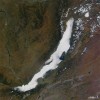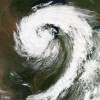Climate
Mild winter, early runoff spur swirling sediment in Lake Erie
|
A mild winter left Lake Erie nearly ice-free. On the first day of spring last week, a NASA satellite snapped a picture of the southern Great Lakes region and showed sediment clouding up the shallow lake. The colors in the image are accurate. The tan colored-water swirling around the shoreline is sediment rushing in from streams and rivers. The warm winter brought more rainfall than snow, so there was increased runoff.






